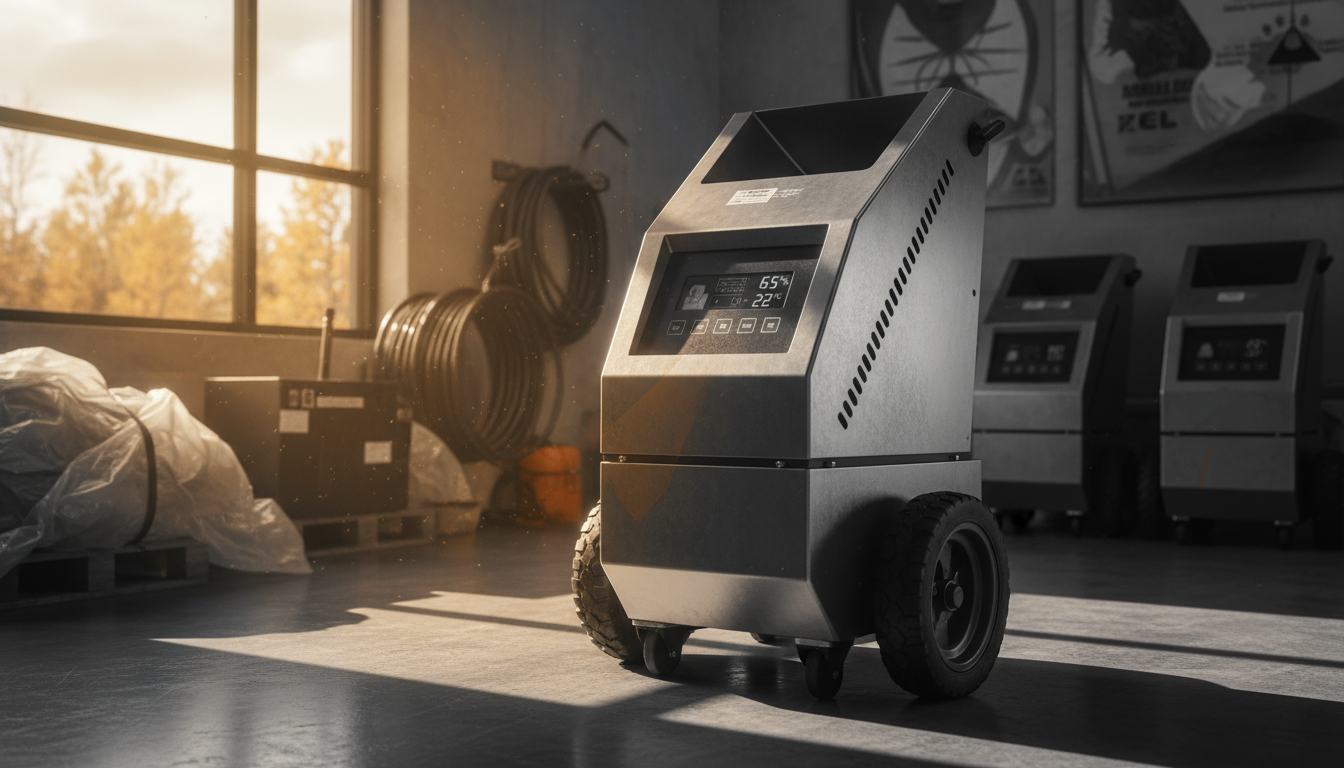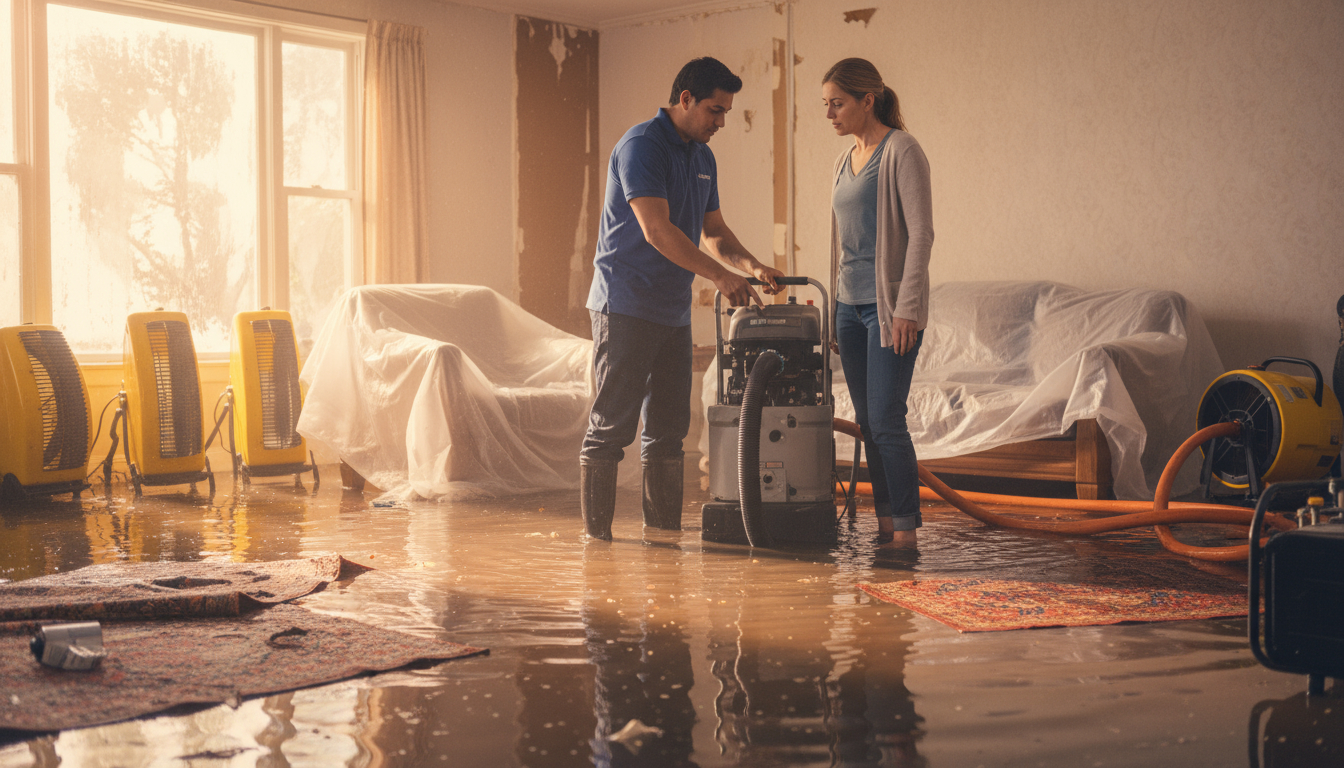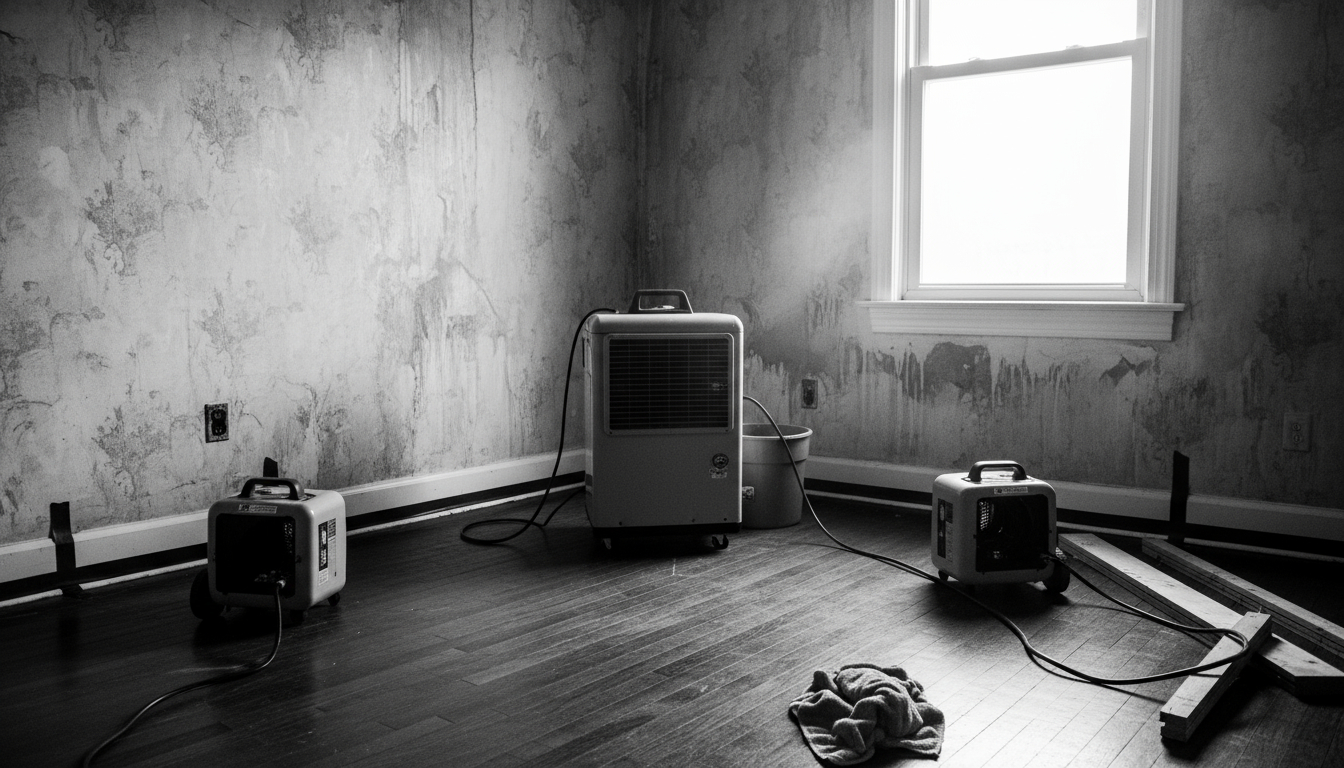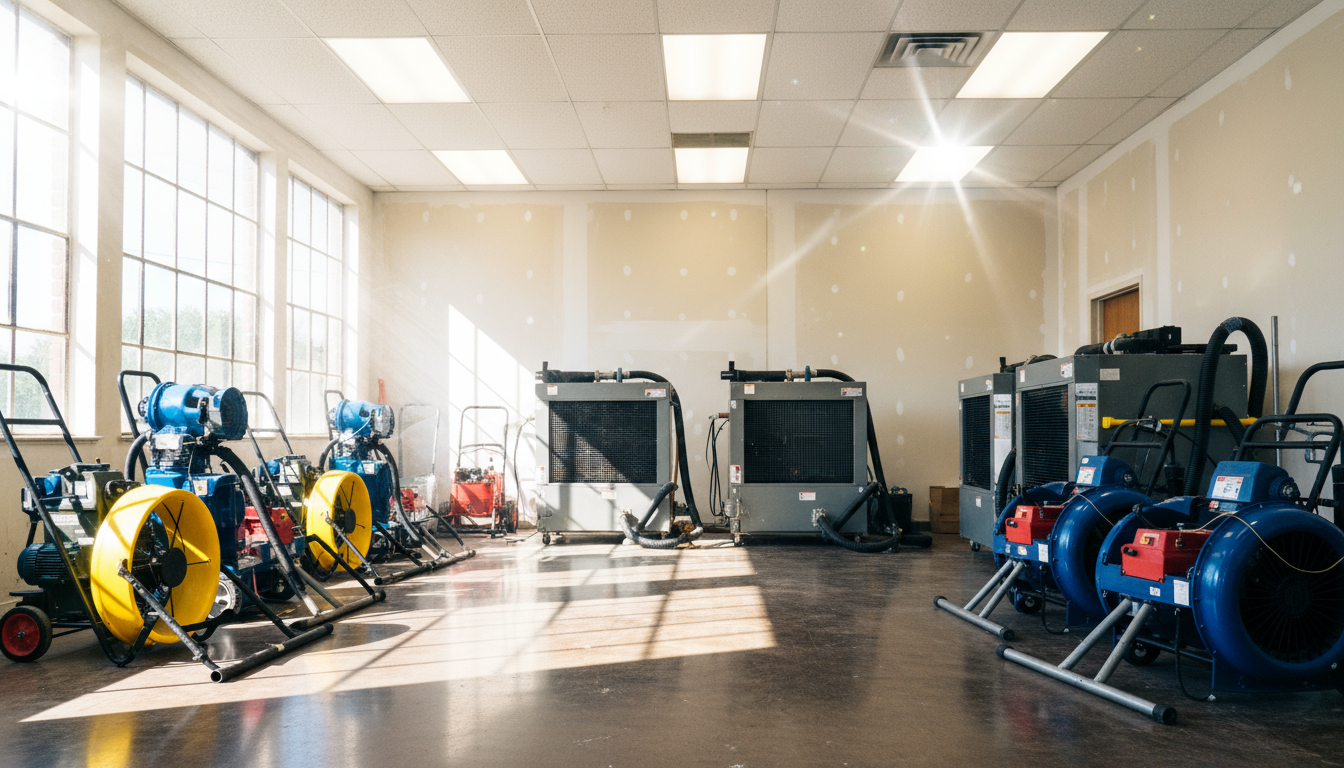What is Restoration Equipment Rental?
Restoration equipment rental provides temporary access to professional-grade tools and machinery specifically designed for property damage restoration and recovery. These specialized systems address water damage, fire damage, mold remediation, and structural drying needs with industrial-strength capabilities that far exceed standard household equipment.
Unlike consumer products found in retail stores, professional restoration equipment rental offers significantly higher performance through increased capacity, precision controls, and commercial durability. A rental dehumidifier, for instance, can remove 10-15 times more moisture than a residential unit, while professional water extraction equipment can handle thousands of gallons per hour compared to the minimal capacity of shop vacuums.
Equipment rental services bridge the gap between emergency needs and long-term investment. Property owners gain immediate access to the same tools used by restoration professionals without purchasing expensive machinery they’ll only need once. This approach ensures proper restoration while maintaining budget flexibility during already stressful situations.
How Does Restoration Equipment Rental Work?
The restoration equipment rental process begins with assessment and selection. Reputable rental providers help you identify the specific equipment needed based on your damage type, property size, and restoration timeline. This consultation ensures you receive appropriate tools rather than overpaying for unnecessary capacity or underestimating your actual needs.
Once equipment is selected, most equipment rental companies offer flexible terms ranging from daily to monthly periods. Delivery and pickup services are typically available for larger equipment, though smaller items like air movers can often be transported in personal vehicles. Professional restoration equipment rental providers include basic operation instructions, though complex situations may require additional training or professional assistance.
During your rental period, you’re responsible for proper equipment operation, basic maintenance, and monitoring results. Many rental agreements include 24/7 support lines for technical questions or equipment issues. Upon completion, equipment is returned, inspected for damage, and your final charges are calculated based on actual rental duration and any consumables used.
Types of Restoration Equipment Available for Rent
Dehumidifier Rental Units
Professional dehumidifier rental units come in three primary categories, each designed for specific moisture removal scenarios. Refrigerant dehumidifiers work efficiently in warm environments, condensing moisture through cooling coils and collecting water in reservoirs or drain lines. These units excel in typical water damage situations where temperatures remain above 60°F and are commonly available through restoration equipment rental services.
Desiccant dehumidifiers use chemical absorption to remove moisture and perform exceptionally well in cold environments or situations requiring extremely low humidity levels. These specialized dehumidifier rental units are essential for freeze damage scenarios or when drying materials sensitive to heat. Low-grain refrigerant (LGR) dehumidifiers represent the most advanced option available in equipment rental, removing moisture more efficiently while operating more quietly than conventional models.
| Dehumidifier Type | Best Applications | Removal Capacity | Temperature Range |
|---|---|---|---|
| Refrigerant | Standard water damage | High (warm conditions) | 60°F and above |
| Desiccant | Cold environments, deep drying | Consistent all temperatures | Below 60°F optimal |
| LGR | Large-scale restoration | Very high efficiency | 40°F and above |

Water Extraction Equipment
Water extraction equipment available through restoration equipment rental ranges from portable extractors to truck-mounted systems capable of removing standing water rapidly. Portable extractors combine vacuuming with heated water injection for deep carpet and upholstery cleaning while simultaneously extracting contaminated water. These versatile units work well for moderate water damage affecting carpeted areas, often used alongside professional water cleanup and extraction services.
Submersible pumps handle larger volumes of standing water in basements or crawl spaces, moving water through hoses to appropriate drainage points. Trash pumps accommodate debris-laden water from sewage backups or flood situations, featuring wider intake openings that prevent clogging. For maximum efficiency, truck-mounted water extraction equipment delivers the highest suction power and water removal rates, though these systems typically require professional operation and are often included in full-service restoration equipment rental packages.
Air Movement and Circulation Systems
Air movers create critical airflow patterns that accelerate evaporation from wet surfaces and materials. These specialized fans produce focused, high-velocity airflow rather than the diffused circulation of household fans. Professional air movers feature variable speed controls, stackable designs for efficient storage, and amperage ratings suitable for operating multiple units on standard circuits.
Axial air movers push large volumes of air in a focused stream, ideal for drying walls, floors, and other flat surfaces. Centrifugal air movers generate higher pressure airflow for directing air into confined spaces like wall cavities or beneath cabinets. Strategic placement of multiple air movers creates coordinated airflow patterns that maximize drying efficiency across entire affected areas.
Specialty Restoration Equipment
Beyond primary drying equipment, specialized tools address unique restoration challenges. Thermal imaging cameras detect hidden moisture in walls, ceilings, and floors without invasive demolition, guiding targeted drying efforts. Moisture meters provide quantitative readings of material water content, documenting drying progress and confirming when materials have reached acceptable levels.
Negative air machines create controlled air pressure environments essential for mold remediation and fire restoration. These units filter contaminated air through HEPA filtration while preventing spore or particle migration to unaffected areas. Hydroxyl generators and ozone machines address odor removal, though these powerful oxidation systems require strict safety protocols and temporary evacuation during operation.
Benefits of Renting Restoration Equipment
Financial flexibility represents the most immediate advantage of restoration equipment rental. Professional restoration equipment carries substantial acquisition expense, making purchase impractical for one-time emergency needs. Equipment rental allows access to precisely the equipment needed without depleting emergency funds or insurance proceeds better allocated to actual repairs and restoration.
Access to current technology ensures your restoration benefits from the latest equipment innovations available through restoration equipment rental services. Rental providers regularly update inventory with newer, more efficient models featuring improved performance and energy efficiency. This continuous upgrade cycle means equipment rental customers always work with well-maintained, current equipment rather than aging machinery requiring costly repairs and updates.
Elimination of long-term ownership responsibilities proves equally valuable with restoration equipment rental. Professional restoration equipment requires regular maintenance, annual calibration, and proper storage when not in use. These ongoing costs and responsibilities disappear with rental arrangements, as providers handle all maintenance, repairs, and storage between rental periods.
💡 Pro Tip: Calculate your total restoration needs before committing to restoration equipment rental periods. Many situations requiring professional equipment also benefit from professional oversight. Consider consulting with restoration specialists who can assess whether equipment rental with DIY labor or full professional service better serves your specific situation and timeline requirements.
Key Factors in Equipment Selection
Damage Assessment and Scope
Accurate damage assessment drives appropriate restoration equipment rental selection. Water damage classification ranges from clean water (Category 1) to grossly contaminated water (Category 3), with each category requiring different handling protocols and equipment capabilities. Category 3 water damage, such as sewage cleanup situations, requires specialized equipment and professional handling. Similarly, damage extent determines whether localized drying equipment suffices or whole-structure drying systems become necessary for your equipment rental needs.
Material types affected by damage influence equipment choices significantly. Hardwood floors, drywall, concrete, and carpet each respond differently to drying methods and require adjusted approaches. Dense materials like concrete may need weeks of dedicated dehumidification, while porous materials like insulation often require removal rather than drying attempts.
Property Size and Configuration
Space dimensions directly impact restoration equipment rental quantity and placement strategies. A general guideline suggests one air mover per 100-150 square feet of affected area, though actual needs vary based on ceiling height, air circulation barriers, and moisture severity. Dehumidifier rental capacity should match the total cubic footage of affected space, accounting for both direct water damage and secondary humidity elevation.
Architectural features like vaulted ceilings, open floor plans, or numerous small rooms affect airflow patterns and equipment positioning. Properties with limited electrical capacity may require load balancing across multiple circuits or even temporary generator supplementation to operate adequate equipment simultaneously. These factors must be considered when planning your equipment rental needs.
Timeline and Urgency
Restoration timeline significantly influences equipment rental selection and rental duration. Standard water damage typically requires 3-5 days of continuous drying with proper equipment, though this extends considerably for extensive damage, dense materials, or secondary complications like microbial growth. Understanding realistic timelines prevents premature restoration equipment rental return and incomplete drying that leads to recurring problems.
Seasonal factors affect drying rates and equipment performance. High ambient humidity during summer months requires more aggressive dehumidification, while winter heating can accelerate drying but introduces temperature management challenges. These environmental variables should inform your equipment selection and expected rental duration from the outset.
The Restoration Equipment Rental Process
Initial Consultation and Planning
Professional restoration equipment rental providers begin with damage assessment and equipment recommendation. This consultation should cover affected areas, water source identification, and preliminary moisture detection. Quality equipment rental providers ask detailed questions about your situation rather than simply processing a transaction, ensuring equipment recommendations match actual needs. For immediate assistance during emergencies, many restoration companies offer 24-hour emergency services.
Documentation practices prove essential from the start. Photograph all affected areas before equipment placement, noting visible damage and equipment positioning. Many insurance policies require detailed documentation of mitigation efforts, including equipment rental receipts and daily monitoring logs tracking drying progress throughout the restoration period.

Equipment Delivery and Setup
Proper equipment placement dramatically impacts restoration effectiveness. Dehumidifiers work most efficiently in central locations with unrestricted airflow, while air movers require strategic positioning to direct airflow across wet surfaces without blowing toward dehumidifier intakes. Professional setup follows established drying principles that maximize equipment interaction and effectiveness.
Electrical requirements demand careful attention during setup. Professional restoration equipment draws significant amperage, with a typical restoration setup potentially requiring 20-40 amps of continuous electrical capacity. Distributing equipment across multiple circuits prevents overloading, while extension cords should be avoided or minimized using only heavy-duty models rated for the equipment amperage.
⚠️ Important: Never operate restoration equipment on circuits also serving refrigerators, freezers, or medical equipment. Circuit overload risks not only equipment damage but potential fire hazards. If adequate electrical capacity isn’t available, consult with an electrician before proceeding with equipment setup.
Operation and Monitoring
Continuous operation proves critical for restoration equipment rental effectiveness. Dehumidifiers and air movers should run 24 hours daily throughout the drying period, as intermittent operation dramatically extends timelines and risks secondary damage development. Only specialty equipment like ozone generators requires timed, evacuated operation for safety reasons.
Daily monitoring ensures restoration equipment rental progress and identifies problems early. Check dehumidifier rental unit reservoirs or drain lines for proper water removal, verify air mover positioning hasn’t shifted, and use moisture meters to track drying progress in affected materials. Document these daily checks with photographs and written notes creating a restoration timeline record.
Safety Considerations During Equipment Rental
Electrical safety requires constant vigilance when operating multiple high-amperage devices simultaneously. Ground fault circuit interrupters (GFCI) provide essential protection in water-damaged environments, immediately shutting off power if current leakage occurs. Never disable GFCI protection even if nuisance tripping occurs—instead, redistribute equipment load or address the underlying electrical issue causing trips.
Physical hazards multiply during restoration periods with equipment, electrical cords, and disrupted household routines creating trip and injury risks. Secure all cords along walls or beneath cord protectors in traffic areas. Position equipment away from stairs, doorways, and high-traffic zones where possible. Children and pets require careful supervision around operating equipment throughout the rental period.
Air quality management becomes crucial during restoration, particularly with fire damage or potential mold involvement. While dehumidifiers and air movers improve ventilation, contaminated materials require containment and proper filtration. If you detect musty odors, visible mold, or respiratory irritation during restoration, stop work immediately and consult restoration professionals about proper remediation protocols.

Equipment Operation Safety
Each equipment type presents specific operational safety requirements. Dehumidifiers generate heat during operation and require adequate clearance around all sides for airflow and heat dissipation. Never place dehumidifiers against walls or furniture, and avoid operating in enclosed spaces without ventilation. Empty condensate reservoirs regularly to prevent overflow and water damage to the equipment itself.
Air movers create powerful airflow that can topple lightweight objects, blow loose materials, or redirect airflow in unintended directions. Secure the units firmly on stable surfaces and angle airflow intentionally toward wet surfaces rather than toward dehumidifier intakes. Never point air movers directly at outlets, electrical panels, or areas where airflow might disturb important materials or documents.
Maintenance Requirements During Rental
Basic maintenance during your restoration equipment rental period ensures continued equipment performance and avoids additional charges. Daily tasks include emptying dehumidifier rental unit reservoirs if not using continuous drainage, cleaning air mover intake screens of dust or debris, and verifying all equipment continues operating properly. These simple checks take minutes but prevent equipment failure that could halt restoration progress.
Filter maintenance proves particularly important for dehumidifiers and air filtration equipment. Clogged filters dramatically reduce efficiency and force equipment to work harder, potentially leading to overheating or failure. Clean or replace filters according to manufacturer specifications, typically every 2-3 days during heavy use. Most equipment rental agreements specify filter cleaning as renter responsibility rather than normal wear and tear.
Equipment positioning requires periodic adjustment as restoration progresses. As surface moisture decreases, repositioning air movers targets remaining wet areas more effectively. Similarly, relocating dehumidifiers to different zones within large properties ensures even drying rather than over-drying some areas while leaving others damp. These strategic adjustments maximize rental equipment effectiveness.
🏠 Home Tip: Create a simple daily checklist for rental equipment monitoring. Include items like reservoir emptying, filter inspection, moisture readings, and equipment operation verification. This systematic approach ensures nothing gets overlooked during the stress of dealing with property damage.
Common Problems and Troubleshooting
Insufficient Drying Progress
When moisture levels aren’t decreasing as expected with your restoration equipment rental, several factors may be contributing. Inadequate equipment capacity for the affected area represents the most common issue—one dehumidifier rental unit rarely suffices for whole-house water damage regardless of marketing claims. Similarly, insufficient air movement prevents evaporation from occurring rapidly enough for dehumidifiers to capture moisture effectively.
Hidden moisture reservoirs can sabotage drying efforts even with properly sized equipment. Water trapped in wall cavities, beneath flooring, or in structural materials continues feeding moisture into the environment faster than equipment can remove it. If surface materials dry but moisture meters still show elevated readings, professional inspection may reveal hidden damage requiring more invasive intervention.
Equipment Performance Issues
Dehumidifiers that run constantly without filling reservoirs or showing moisture removal may have failed refrigerant systems, clogged coils, or airflow obstructions. Check air filters first, clean intake and exhaust areas, and verify the unit is positioned with adequate clearance. If problems persist, contact your restoration equipment rental provider immediately rather than continuing to operate malfunctioning equipment.
Air movers that overheat, make unusual noises, or produce burning smells require immediate shutdown and replacement. These symptoms indicate motor problems, bearing failure, or electrical issues that present fire risks. Never attempt to repair rental equipment yourself—notify your provider and arrange replacement units to maintain restoration progress without safety compromise.
Electrical Circuit Overload
Frequent circuit breaker trips indicate electrical overload from too much equipment on a single circuit. Calculate total amperage requirements and redistribute equipment across multiple circuits, ensuring no single circuit exceeds 80% of its rated capacity for continuous operation. If adequate circuits aren’t available, reduce total equipment or consult an electrician about temporary solutions.
GFCI outlets that trip repeatedly suggest current leakage from damaged equipment or wet electrical components in the environment. Replace equipment exhibiting this problem and inspect the area for wet outlets, switches, or electrical boxes. Water and electricity create dangerous situations requiring professional attention rather than attempts to bypass safety systems.
When to Call Professional Restoration Services
While equipment rental provides tools for restoration, complex situations benefit from professional expertise guiding equipment use and overall restoration strategy. Category 2 or 3 water damage involves contaminated water requiring specialized handling protocols beyond simple drying. These situations demand professional assessment for health safety and proper contamination containment.
Structural concerns like sagging ceilings, buckled floors, or visible material deterioration indicate damage severity exceeding DIY restoration capabilities. Professionals understand building science and material behavior, recognizing when drying attempts prove futile and replacement becomes necessary. This expertise prevents wasted rental expenses on equipment that cannot solve underlying problems. Similarly, fire and smoke damage restoration requires specialized knowledge and equipment beyond what rental alone can provide.
Insurance claim optimization often justifies professional involvement even when equipment rental seems more economical initially. Restoration professionals document damage thoroughly, communicate directly with insurance adjusters, and understand what insurance policies typically cover. This expertise can mean the difference between partial and full claim payment, often exceeding any cost difference between DIY and professional approaches.
Timeline considerations also favor professional services for many property owners. While rental equipment provides tools, restoration remains a full-time job requiring constant attention, monitoring, and adjustment. Property owners juggling work, family, and recovery stress may find professional services actually more cost-effective when considering time investment and peace of mind. For business owners, commercial restoration services minimize downtime and ensure compliance with industry regulations.
Investment Considerations for Equipment Rental
Restoration equipment rental terms and conditions vary significantly between providers, affecting your total investment beyond daily or weekly rental rates. Delivery fees, pickup charges, damage waivers, and consumable supplies can substantially impact final expenditures. Request detailed quotations including all fees and charges before committing to equipment rental agreements, ensuring transparency about total restoration investment.
Insurance coverage frequently includes restoration equipment rental as part of mitigation expenses, though policies vary in coverage limits and approval requirements. Contact your insurance adjuster before renting equipment to understand coverage parameters and documentation requirements. Many insurers prefer working with approved vendors or may require pre-authorization for significant equipment rental to ensure claim payment.
Comparing rental versus professional service investment requires comprehensive analysis beyond simple equipment expenses. Factor in your time commitment, the learning curve for proper equipment use, risks of incomplete restoration requiring additional work, and stress during an already difficult period. Sometimes the seemingly more expensive professional service proves more economical when considering all factors comprehensively.
Maximizing Rental Value
Several strategies help optimize your restoration equipment rental investment. Accurate damage assessment from the start ensures you rent appropriate equipment capacity, avoiding inadequate results or overpaying for excess capacity. Consultation with restoration professionals—even if not hiring full services—can provide valuable guidance on equipment rental selection and usage strategies.
Efficient restoration equipment rental timing minimizes expenses while ensuring adequate restoration duration. Starting equipment immediately after water extraction equipment completes its work prevents extended damage while materials remain wet. However, avoid premature equipment return before materials reach proper dryness levels, as recurring moisture problems prove far more expensive than additional rental days.
Documentation throughout your rental period serves multiple purposes. Detailed records support insurance claims, demonstrate proper mitigation efforts, and provide evidence if questions arise about restoration adequacy. Photograph equipment placement, maintain daily monitoring logs, and retain all receipts and rental agreements creating a comprehensive restoration record.
Frequently Asked Questions
How long do I need to rent restoration equipment after water damage?
Most water damage situations require 3-5 days of continuous equipment operation for proper drying, though extensive damage may need 7-10 days or longer. The timeline depends on water volume, affected materials, and ambient conditions. Never return equipment based solely on surface dryness—use moisture meters to confirm materials have reached acceptable moisture levels before ending your rental period.
Can I use regular fans and a household dehumidifier instead of renting professional equipment?
Consumer equipment lacks the capacity for effective restoration in most water damage scenarios. A professional dehumidifier removes 10-15 times more moisture than residential units, while restoration air movers produce focused, high-velocity airflow that household fans cannot match. For minor spills affecting small areas, consumer equipment might suffice, but significant water damage requires professional-grade equipment for proper, timely restoration.
What are the signs that my restoration equipment rental is working properly?
Effective restoration equipment rental shows steady moisture reduction in affected materials measured with moisture meters, visible water accumulation in dehumidifier rental unit reservoirs or drain lines, and gradually drying surfaces. You should feel warm air from dehumidifier exhaust and strong, focused airflow from air movers. If moisture readings aren’t decreasing after 48 hours of operation, reassess equipment capacity or consult restoration professionals about potential hidden moisture sources.
Do I need special electrical setup to run restoration equipment?
Most restoration equipment operates on standard 120-volt circuits, but amperage requirements demand attention. A typical setup draws 20-40 amps total, requiring distribution across multiple circuits to prevent overload. Ensure equipment connects to GFCI-protected outlets in water-damaged areas. If your property has limited electrical capacity or older wiring, consult an electrician before operating multiple high-amperage units simultaneously.
Should I rent equipment or hire professional restoration services?
Restoration equipment rental works well for straightforward water damage from clean sources affecting accessible areas when you have time for constant monitoring. However, contaminated water, structural concerns, extensive damage, insurance claim complexity, or limited personal time often make professional services more appropriate. Professionals provide equipment rental, expertise, documentation, and comprehensive restoration services that frequently prove more cost-effective when considering all factors.
What happens if rental equipment breaks down during my restoration?
Reputable restoration equipment rental providers offer equipment replacement for failures during normal operation, typically providing replacement units within 24 hours. Report equipment problems immediately rather than continuing to operate malfunctioning units. Keep equipment rental provider contact information readily accessible and document equipment issues with photographs. Most rental agreements exclude damage from misuse but cover normal wear and mechanical failures during proper operation.
Making Informed Equipment Rental Decisions
Restoration equipment rental provides property owners with access to professional-grade tools essential for proper damage recovery without long-term investment in specialized machinery. Understanding equipment types, selection criteria, and operational requirements helps you make informed decisions about restoration equipment rental approaches versus professional services for your specific situation.
The key to successful equipment rental lies in honest assessment of damage severity, your available time and technical capability, and realistic expectations about restoration timelines. While restoration equipment rental provides powerful tools, restoration remains a demanding process requiring sustained attention, proper technique, and sometimes professional expertise for optimal results.
Whether you choose restoration equipment rental for hands-on restoration or professional services for comprehensive damage recovery, prompt action proves critical. Every hour of delay allows water damage to spread, increases structural deterioration risks, and elevates microbial growth potential. The right equipment, properly deployed at the right time, makes all the difference between successful restoration and escalating property damage.
Need Expert Guidance on Restoration Equipment?
Advanced DRI provides professional restoration services with state-of-the-art equipment and expert technicians throughout the Hudson Valley region and surrounding areas. Whether you need equipment consultation, comprehensive restoration services, or emergency response, our team delivers the expertise and solutions your property demands.
Contact Advanced DRI today for immediate assistance with your restoration needs.

